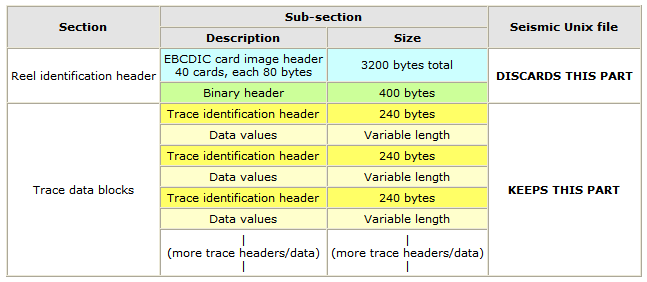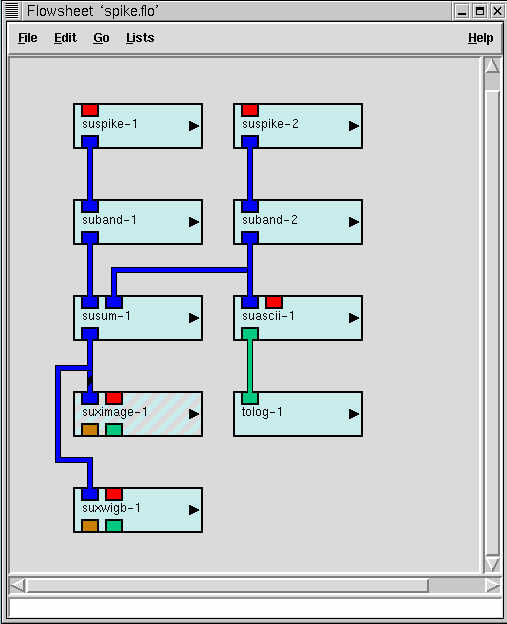
|
Surveys and data Instruments
Support to other department sections Support Dr. Scient. thesis Contribution to "Scientific infrastructure"
Obsolete, kept for reference
Last update: April 30, 2025, at 08:49 AM |
USING SeismicUnixConversion of SEG-B, SEG-C to Seismic Unix formatSEG-Y data format and how it differs from the Seismic Unix formatIn order to process data with Seismic Unix you need to be familiar with the layout of SEG-Y files and how it differs from the Seismic Unix (SU) data format. First, get the SEG-Y standard from The Society of Exploration Geophysicists (SEG): The SEG-Y format specification from SEG:
This is how a SEG-Y file looks like:  SEG-Y format structure. The SU data format consists of the trace data blocks ONLY. The reel identification header can later be inserted when data is exported in the SEG-Y format. SU files stores floating point values in "the native binary format of the machine you are running the programs on" - quote from section 3.1.1 (p.21) of the SeismicUnix manual. It's difficult to spot a mix-up of IBM floating point format (as used in SEG-Y files) and IEEE 754 floating point format (the floating point format used by e.g. PCs). Here's some background information. SEG-Y Reel Identification HeaderSee this document (local copy). The 3200 byte SEG-Y EBCDIC Reel Header12345678901234567890123456789012345678901234567890123456789012345678901234567890 C 1 CLIENT COMPANY CREW NO C 2 LINE AREA MAP IS C 3 REEL NO DAY-START OF REEL YEAR OBSERVER C 4 INSTRUMENT: MFG MODEL SERIAL NO C 5 DATA TRACES/RECORD AUXILIARY TRACES/RECORD CDP FOLD C 6 SAMPLE INTERVAL SAMPLES/TRACE BITS/IN BYTES/SAMPLE C 7 RECORDING FORMAT FORMAT THIS REEL MEASUREMENT SYSTEM C 8 SAMPLE CODE: FLOATING PT FIXED PT FIXED PT-GAIN CORRELATED C 9 GAIN TYPE: FIXED BINARY FLOATING POINT OTHER C10 FILTERS: ALIAS HZ NOTCH HZ BAND - HZ SLOPE - DB/OCT C11 SOURCE: TYPE NUMBER/POINT POINT INTERVAL C12 PATTERN: LENGTH WIDTH C13 SWEEP: START HZ END HZ LENGTH MS CHANNEL NO TYPE C14 TAPER: START LENGTH MS END LENGTH MS TYPE C15 SPREAD: OFFSET MAX DISTANCE GROUP INTERVAL C16 GEOPHONES: PER GROUP SPACING FREQUENCY MFG MODEL C17 PATTERN: LENGTH WIDTH C18 TRACES SORTED BY: RECORD CDP OTHER C19 AMPLITUDE RECOVERY: NONE SPHERICAL DIV AGC OTHER C20 MAP PROJECTION ZONE ID COORDINATE UNITS C21 PROCESSING: C22 PROCESSING: C23 C24 C25 C26 C27 C28 C29 C30 C31 C32 C33 C34 C35 C36 C37 C38 C39 C40 END EBCDIC The 400 byte SEG-Y Binary Reel Header
--------------------------------------------------------------------------------
Bytes Description
--------------------------------------------------------------------------------
001 - 004 Job identification number.
005 - 008 * Line number.
009 - 012 * Reel number.
013 - 014 * Number of data traces per record.
015 - 016 * Number of auxiliary traces per record.
017 - 018 * Sample interval of this reel's data in microseconds
019 - 020 Sample interval of original field recording in microseconds.
021 - 022 * Number of samples per trace for this reel's data.
023 - 024 Number of samples per trace in original field recording.
025 - 026 * Data sample format code:
1 = 32-bit IBM floating point
2 = 32-bit fixed-point (integer)
3 = 16-bit fixed-point (integer)
4 = 32-bit fixed-point with gain code (integer)
$ 5 = 32-bit IEEE floating point
$ 6,7 = Not currently used
$ 8 = 8-bit, two's complement integer)
027 - 028 * CDP fold (expected number of data traces per ensemble).
029 - 030 Trace sorting code:
1 = as recorded
2 = CDP ensemble
3 = single fold continuous profile
4 = horizontally stacked
031 - 032 Vertical sum code (1 = no sum, 2 = two sum, ...)
033 - 034 Sweep frequency at start in Hertz.
035 - 036 Sweep frequency at end in Hertz.
037 - 038 Sweep length in milliseconds.
039 - 040 Sweep type code:
1 = linear
2 = parabolic
3 = exponential
4 = other
041 - 042 Trace number of sweep channel.
043 - 044 Sweep trace taper length at start in milliseconds.
045 - 046 Sweep trace taper length at end in milliseconds.
047 - 048 Taper type code:
1 = linear
2 = cosine squared
3 = other
049 - 050 Correlated data traces (1 = no, 2 = yes).
051 - 052 Binary gain recovered (1 = yes, 2 = no).
053 - 054 Amplitude recovery method code:
1 = one
2 = spherical divergence
3 = AGC
4 = other
055 - 056 * Measurement system (1 = meters, 2 = feet).
057 - 058 Impulse signal polarity (increase in pressure or upward
geophone case movement gives 1=negative or 2=positive number).
059 - 060 Vibratory polarity code (seismic lags pilot signal by):
1 = 337.5 to 22.5 degrees
2 = 22.5 to 67.5 degrees
3 = 67.5 to 112.5 degrees
4 = 112.5 to 157.5 degrees
5 = 157.5 to 202.5 degrees
6 = 202.5 to 247.5 degrees
7 = 247.5 to 292.5 degrees
8 = 292.5 to 337.5 degrees
061 - 400 Unassigned (for optional information)s
* strongly recommended
$ Defined in rev 1 of the SEGY standard
SEG-Y Trace Identification HeaderThe 240-byte binary trace header consists of 2-byte and 4-byte integers:
--------------------------------------------------------------------------------------------------------
Byte # 2/4-byte SU Keyword Description
--------------------------------------------------------------------------------------------------------
001 - 004 4 * tracl Trace sequence number within line.
005 - 008 4 tracr Trace sequence number within reel.
009 - 012 4 * fldr Original field record number.
013 - 016 4 * tracf Trace sequence number within original field record.
017 - 020 4 ep Energy source point number.
021 - 024 4 cdp CDP ensemble number.
025 - 028 4 cdpt Trace sequence number within CDP ensemble.
029 - 030 2 * trid Trace identification code:
1 = seismic data
2 = dead
3 = dummy
4 = time break
5 = uphole
6 = sweep
7 = timing
8 = water break
9+ = optional use
SU specific id codes, look here
031 - 032 2 nvs Number of vertically summed traces yielding this trace.
033 - 034 2 nhs Number of horizontally stacked traced yielding this trace.
035 - 036 2 duse Data use (1 = production, 2 = test).
037 - 040 4 offset Distance from source point to receiver group.
041 - 044 4 gelev Receiver group elevation.
045 - 048 4 selev Surface elevation at source.
049 - 052 4 sdepth Source depth below surface.
053 - 056 4 gdel Datum elevation at receiver group.
057 - 060 4 sdel Datum elevation at source.
061 - 064 4 swdep Water depth at source.
065 - 068 4 gwdep Water depth at receiver group.
069 - 070 2 scalel Scalar for elevations and depths (+ = multiplier, - = divisor).
071 - 072 2 scalco Scalar for coordinates (+ = multiplier, - = divisor).
073 - 076 4 sx X source coordinate.
077 - 080 4 sy Y source coordinate.
081 - 084 4 gx X receiver group coordinate.
085 - 088 4 gy Y receiver group coordinate.
089 - 090 2 counit Coordinate units (1 = length in meters or feet, 2 = arc seconds).
091 - 092 2 wevel Weathering velocity.
093 - 094 2 swevel Subweathering velocity.
095 - 096 2 sut Uphole time at source.
097 - 098 2 gut Uphole time at receiver group.
099 - 100 2 sstat Source static correction.
101 - 102 2 gstat Receiver group static correction.
103 - 104 2 tstat Total static applied.
105 - 106 2 laga Lag time between end of header and time break in milliseconds.
107 - 108 2 lagb Lag time between time break and shot in milliseconds.
109 - 110 2 delrt Lag time beteen shot and recording start in milliseconds.
111 - 112 2 muts Start of mute time.
113 - 114 2 mute End of mute time.
115 - 116 2 * ns Number of samples in this trace.
117 - 118 2 * dt Sample interval of this trace in microseconds.
119 - 120 2 gain Field instrument gain type code:
1 = fixed
2 = binary
3 = floating point
4+ = optional use
121 - 122 2 igc Instrument gain constant.
123 - 124 2 igi Intrument early gain in decibels.
125 - 126 2 corr Correlated (1 = no, 2 = yes).
127 - 128 2 sfs Sweep frequency at start.
129 - 130 2 sfe Sweep fequency at end.
131 - 132 2 slen Sweep length in milliseconds.
133 - 134 2 styp Sweep type code:
1 = linear
2 = parabolic
3 = exponential
4 = other
135 - 136 2 stas Sweep taper trace length at start in milliseconds.
137 - 138 2 stae Sweep taper trace length at end in milliseconds.
139 - 140 2 tatyp Taper type code:
1 = linear
2 = cosine squared
3 = other
141 - 142 2 afilf Alias filter frequency.
143 - 144 2 afils Alias filter slope.
145 - 146 2 nofilf Notch filter frequency.
147 - 148 2 nofils Notch filter slope.
149 - 150 2 lcf Low cut frequency.
151 - 152 2 hcf High cut frequency.
153 - 154 2 lcs Low cut slope.
155 - 156 2 hcs High cut slope.
157 - 158 2 year Year data recorded.
159 - 160 2 day Day of year.
161 - 162 2 hour Hour of day (24-hour clock).
163 - 164 2 minute Minute of hour.
165 - 166 2 sec Second of minute.
167 - 168 2 timbas Time basis (1 = local, 2 = GMT, 3 = other).
169 - 170 2 trwf Trace weighting factor for fixed-point format data.
171 - 172 2 grnors Geophone group number of roll switch position one.
173 - 174 2 grnofr Geophone group number of first trace of original field record.
175 - 176 2 grnlof Geophone group number of last trace of original field record.
177 - 178 2 gaps Gap size (total number of groups dropped).
179 - 180 2 otrav Overtravel associated with taper (1 = down/behind, 2 = up/ahead).
181 - 240 Unassigned (for optional information).
* strongly recommended For SU assignments of positions 181 - 240, look here. Relationship between fldr, ep, tracl, tracr, tracfLet's reiterate:
Assumptions:
 Seismic Unix (SU) links
 SU Quick Install, version 40Assuming CWPHOME=/usr/local/SU and that you're on a Linux Intel box (we're using Fedora 7).
1. In /etc/profile (or profile.local):
CWPROOT="/usr/local/SU"
PATH="$PATH:/usr/local/SU/bin"
export PATH CWPROOT
Log out, then in again.
2. Do NOT install as root.
Get ftp://ftp.cwp.mines.edu/pub/cwpcodes/cwp_su_all_40.tgz
Save in /usr/local/SU
First make this directory (as root), then change ownership:
mkdir /usr/local/SU
chown xxx /usr/local/SU
(assuming you are user xxx)
Uncompress:
cd /usr/local/SU/
tar -xzvf cwp*
3. First install these packages on your linux box : compat-gcc-34 (else suxgraph will not work properly), all lesstif packages.
4. Rename /usr/local/SU/Makefile.config:
mv Makefile.config Makefile.config.original
Download this Makefile.config file and put it in /usr/local/SU/src.
Note: From release 39 (this configuration will provide support for large files > 2GB.)
5. You're not root, are you? If not:
cd /usr/local/SU/src
make install
make xtinstall
If you want to compile additional code, check README_TO_INSTALL
6. Test the installation:
suplane | suxgraph &
suplane | suximage &
Use <CTRL>+h to change colour palette, to get this (click to enlarge):
segdread: Important note on gcc version 3.2.2 (RedHat 9.0), gcc version 3.3.4 (SUSE 9.2)There are problems with gcc version 3.2.2 (RedHat 9.0), and version 3.3.4 (SUSE 9.2) - the segdread will be broken. To recompile segdread first get the compat-gcc RPM's (or you can download a binary segdread compiled on FC1 Linux with compat-gcc from here; place it in the $CWPROOT/bin directory, overwriting the old version): compat-gcc-7.3-2.96.118.i386.rpm compat-gcc-c++-7.3-2.96.118.i386.rpm compat-libstdc++-7.3-2.96.118.i386.rpm compat-gcc-g77-7.3-2.96.118.i386.rpm Then rpm -Uvh compat* You must first remove or rename the original version of $CWPROOT/bin/segdread before proceeding, Then edit Makefile.config by setting CC = gcc296 Recompile segdread by make sfremake You can also compile SU from scratch with gcc version 2.9.6. |